Birds bring a joy to gardens that contrasts with yet complements the pleasures we get from plants and trees. Plants generally stay in the places we plant them, and grow relatively slowly.
Birds, however, seem capricious and are all about movement, thanks to their gift of flight. In smaller gardens at least, birds are mostly fleeting visitors, presenting a display of variety that differs in detail every minute.
The ‘resident’ robin whose irrepressible song has sustained through the winter may not be the same robin you hear singing in spring, from the same tree. Most species migrate
Even in a large garden, with abundant nest sites, birds will always come from elsewhere for food, or mates. Besides, the “resident” robin whose irrepressible song has sustained through the winter may not be the same robin you hear singing in spring, from the same tree. Most species migrate seasonally, some very locally, and others, like the swallow, visit our gardens from other continents.
There are several ways to attract more birds to your garden, and to keep them there for longer periods, making them easier to identify, observe and enjoy. (I explain more at the end of this guide.)
Naming birds is not essential to enjoying them. But I like the rationale of the British nature writer Richard Mabey. Learning to distinguish species, he says, gives us a portal into the window of small detail: “I’m comforted by the act of naming. It’s a kind of befriending, a recognition, however temporary, of individuality and provenance.”
If you want to befriend your garden birds in this way, you could start with the images, text and sounds below.
It may help to group them in families of related species. Among the most common visitors to your garden are likely to be members of the diminutive tit family, the blue tit, the great tit and the coal tit. They are all similar in their rather portly little bodies, and in behaviour, but they show off distinctive colour patterns.
Most people can probably pick out some of the crow family without help. You will find in this guide not only the hooded crow but also the rook, the jackdaw and, perhaps surprisingly, the magpie
Finches are also small birds, but with a neater, more streamlined shape than tits, and very varied plumage, not just between species but sometimes between sexes, as in two of the three illustrated below.
Most people can probably pick out some of the crow family without any help. You will find below not only the hooded crow but also the rook, the jackdaw and, perhaps more surprisingly, the much more colourful magpie.
Other garden birds with more or less close relationships are the thrushes: the song thrush, the blackbird and, more distantly related, the familiar robin.
The wood pigeon is also quite closely connected to the collared dove.
Of course, you may see birds in your garden that are not as widespread as the ones illustrated. The great spotted woodpecker, which began to breed in Ireland only in 2008, is now a quite common, but always dramatic, sight at bird feeders in several counties.
And don’t forget to look up at the sky. Many birds that won’t visit your garden may fly overhead, from V-shaped flocks of brent geese to soaring buzzards.
The 20 most spotted birds in Irish gardens
1 Robin

One of our most familiar and easily identifiable birds, with its brightly coloured red breast. Males and females look identical, but fledglings have thrush-like pale spotting. Typical size: 14cm. ► Tap to listen to a robin
2 Blackbird
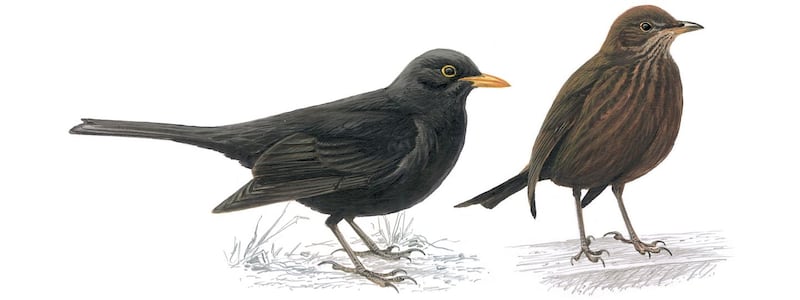
Our most common thrush. Males are all black with a bright yellow bill. Females are browner with a duller bill. Typical size: 25cm. ► Tap to listen to a blackbird
3 Blue tit

Smaller than the great tit (bird no 5), and a frequent visitor to peanut feeders. It has a blue cap, white cheeks and yellow underparts. Young birds are more yellowish overall. Typical size: 12cm. ► Tap to listen to a blue tit
4 Chaffinch

This striking finch often feeds on the ground beneath bird tables. The male is blue on the crown and the back of the neck, with a pinkish-red face and breast and two prominent white wingbars, while the female is a dull brown, darker above than below, again with two white wingbars. Typical size: 15cm. ► Tap to listen to a chaffinch
5 Great tit

The largest member of the tit family. It has a black head with white cheeks. The underparts are bright yellow with a wide black stripe, which is wider in males than in females. Typical size: 14cm. ► Tap to listen to a great tit
6 Magpie

Distinctive, noisy black-and-white bird with a long tail. At close range the black patches show a green and purple iridescent gloss. Typical size: 45cm. ► Tap to listen to a magpie
7 Goldfinch

Very colourful, with a red and black face and black and yellow wings. Often seen on peanut feeders, this species also loves feeding on teasel and thistle heads. Typical size: 13cm. ► Tap to listen to a goldfinch
8 House sparrow

A familiar streaky-brown garden visitor, the male has a large black bib, dark brown head with a grey crown, pale grey underparts and a small white bar on each wing. The female is a duller beige overall, with a streaky-brown back and a paler beige stripe just above the eye. Typical size: 15cm. ► Tap to listen to a house sparrow
9 Wren

One of our smallest species, as well as being the most widespread. Identified by brown, barred plumage and short tail, usually held cocked. Typical size: 10cm. ► Tap to listen to a wren
10 Coal tit

The smallest of the tit family, it is mainly black and grey with whitish cheek patches. The white patch at the back of its neck distinguishes it from other species. Typical size: 11cm. ► Tap to listen to a coal tit
11 Starling
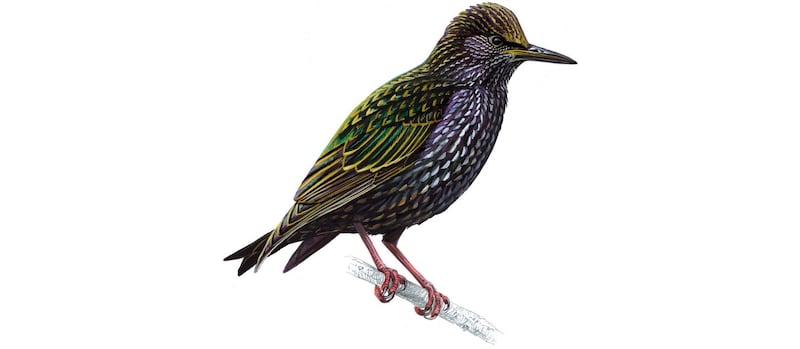
Often seen in flocks on lawns or at bird tables. Noisy, dark birds with long pointed bills; at close range, adults often show iridescent colours and fine white spotting. Frequently mimics the songs and calls of other birds. Large flocks heading to roost often resemble wisps of smoke as they twist and turn in the evening sky. Typical size: 20cm. ► Tap to listen to a starling
12 Dunnock

A shy, skulking bird, often seen hopping about under the bird table or at the edge of flower beds. It has dark streaks on its brown body, pinkish legs and a slight blue-grey cast to the face. Its scratchy song is sometimes said to resemble the sound made by an unoiled shopping-trolley wheel. Typical size: 14cm. ► Tap to listen to a dunnock
13 Woodpigeon
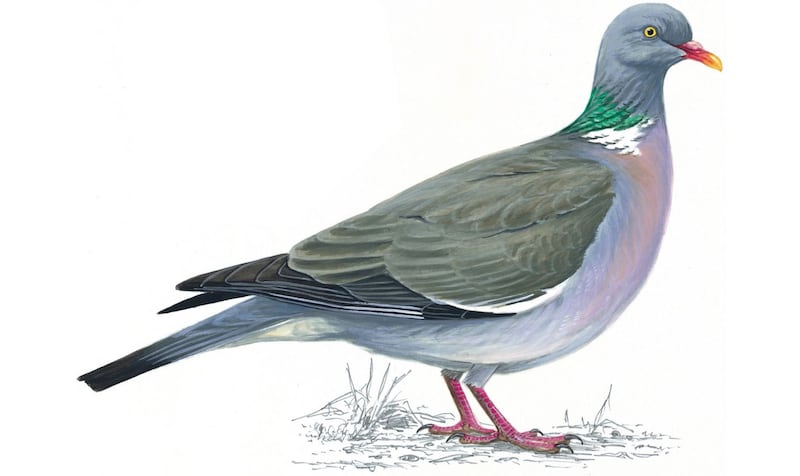
Our largest pigeon, instantly recognisable by the white patch on each side of its neck (absent in young birds) and the broad white band visible on each wing when in flight. Often seen foraging on open lawns. Typical size: 41cm. ► Tap to listen to a woodpigeon
14 Jackdaw
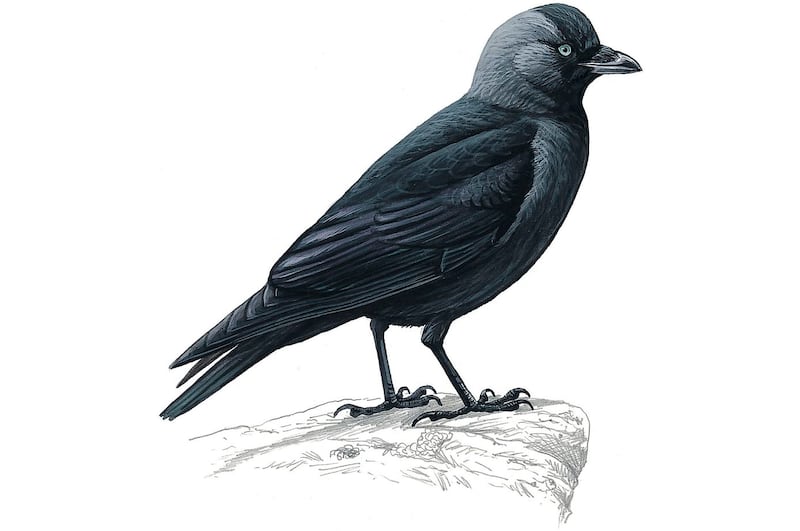
Our smallest dark-coloured crow, frequently seen alongside rooks (bird no 16). On close inspection it appears very dark grey rather than black, and it has a noticeably paler silver-grey patch at the back of its head and neck. Often nests in chimneys. Typical size: 33cm. ► Tap to listen to a jackdaw
15 Song thrush
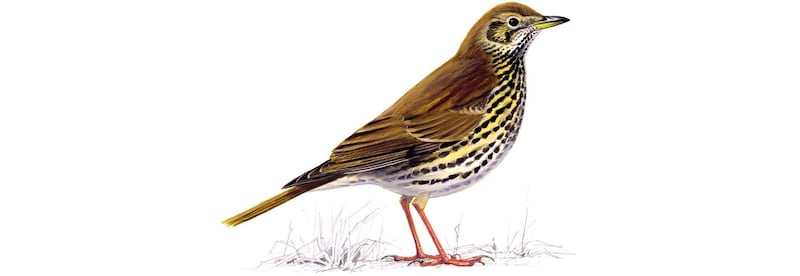
This bird is one of our best songsters. Its most striking feature is its distinctly spotted breast. Slightly smaller than the blackbird and significantly smaller than the similar mistle thrush, from which it can also be distinguished by its warmer brown colour, smaller spots and orange underwings. Enjoys eating snails, which it breaks open on habitually-used flat stones known as "thrush anvils". Typical size: 22cm. ► Tap to listen to a song thrush
16 Rook
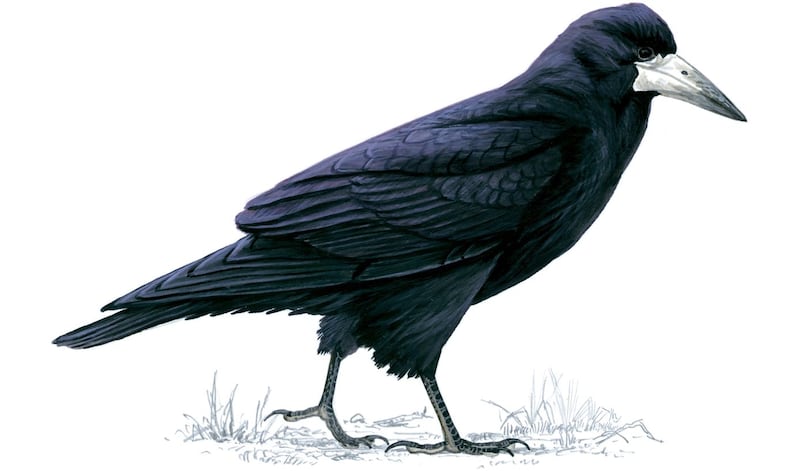
A very common, large, all-black crow, often seen in flocks. Most common on farmland and along roadsides, but will also visit gardens. Adults can be distinguished from other crow species by the contrasting bare patch of pale skin at the base of the bill. Typical size: 47cm. ► Tap to listen to a rook
17 Collared dove

Quite a small, elegant, long-tailed dove, mostly greyish-beige in colour with a prominent black half-collar around its neck. In flight, tail shows much white near the tip. Feeds on the ground, looking for seeds and grain. Typical size: 33cm. ► Tap to listen to a collared dove
18 Hooded crow
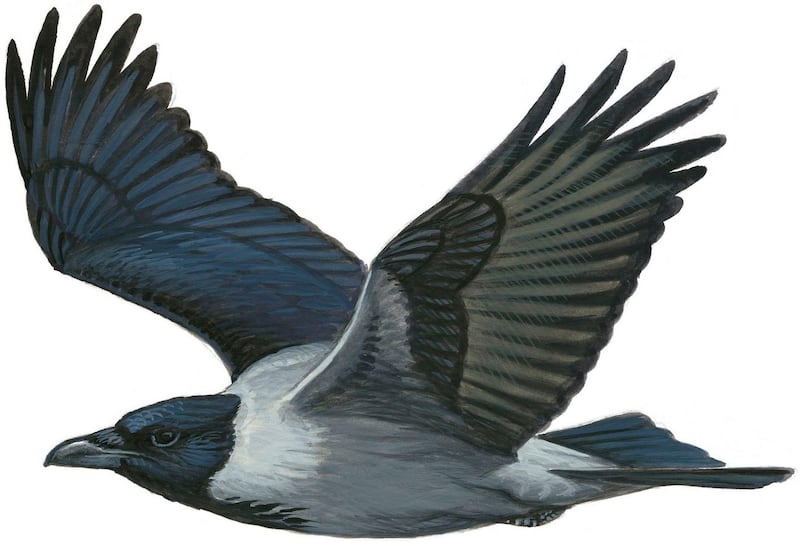
Slightly larger than a rook (bird no 16), from which it can easily be distinguished by its two-tone black and grey plumage. Noisy and aggressive, this species is usually dominant over other crow species. Typical size: 49cm. ► Tap to listen to a hooded crow
19 Greenfinch

Frequent visitor to peanut and seed feeders, though numbers have declined in Ireland in recent years. Males are bright green with yellow wing stripes, females are a dull olive colour. Often seen in small feeding flocks. Typical size: 15cm. ► Tap to listen to a greenfinch
20 Pied wagtail

Familiar and confiding, this is our commonest wagtail. Strikingly black and white (females and young birds are greyer), with a very long tail which it constantly bobs up and down. Often seen searching for insects on concrete, asphalt and lawns. Typical size: 18cm. ► Tap to listen to a wagtail
How to attract birds to your garden
Learning the common species also contributes to their conservation, responding to the global biodiversity emergency that threatens our future. Destruction of natural habitats has made gardens very important havens for birds; by recording your garden birds on the winter survey organised by BirdWatch Ireland, you will be helping the most popular citizen-science project in Ireland. Its website also offers good advice on providing feeding and nesting sites to birds in your garden.
The three main ways to attract birds to your garden are: putting out artificial feeders; growing plants and trees that provide food and nesting opportunities; and putting up artificial nest boxes.
Feeders are the easiest option. A simple peanut or fatball feeder will attract many birds, especially tits, while finches love seeds. You don’t even need a garden – feeders with suckers attached can bring birds to a fifth-storey apartment window.
Pieces of fruit impaled on stout twigs may draw shy birds like the blackcap, an exquisite songster, to your garden. Mealworms and grubs, commercially available oven-dried, are popular with robins and other species. Remember to provide shallow water dishes for bathing and drinking.
It’s worth shopping around for feeders sturdy enough to avoid breakage, especially when disassembling them for cleaning. Cleanliness is vital, to prevent spreading disease. It’s a good idea to move feeders around, but always keep them out of reach of cats, and of rodents.
Planting your garden to attract birds is a vast subject, and books like Jane Powers’s The Living Garden and, in much more detail, Robert Burton’s Birdfeeder Garden offer abundant guidance.
One good principle is to stop “tidying up” by removing all your seed heads. That way, you are providing natural seasonal feeders, especially for finches. And if you can leave “wild” patches for nettles and docks, you will also be offering a banquet to insect-eating birds, and perhaps some cover for ground-nesters.
Choosing (or even building) nest boxes is also a big topic, but remember to put any boxes out early, ideally in winter, so birds can get used to them before the breeding season. They will also provide winter roosts for species like wrens.
You'll find comprehensive advice in the book Ireland's Garden Birds, by Oran O'Sullivan and Jim Wilson, and on this BirdWatch Ireland page. – Paddy Woodworth
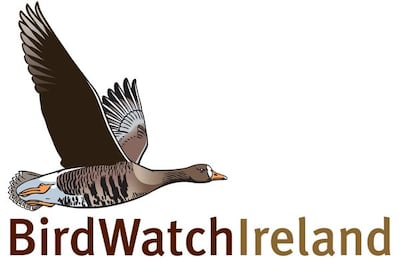
BirdWatch Ireland membership One of the best ways to help wildlife in Ireland is to become a member of BirdWatch Ireland. It also makes a wonderful gift for anyone who has an interest in nature. For full details or to become a member, please visit birdwatchireland.ie or call 01-2819878 All illustrations by Mike Langman/rspb-images.com; the relative sizes of the birds as they appear in this guide are approximate. Birdsong recorded by Susanne Kuijpers, Frode Falkenberg, Ireneusz Oleksik, Peter Boesman, Bernard Collet, Simon Elliott, Markus Jacobs, Stanislas Wroza, Lars Edenius, Jarek Matusiak, Andrew Harrop, Robert Ekman, Alan Dalton and Dag Österlund, via xeno-canto.org
















